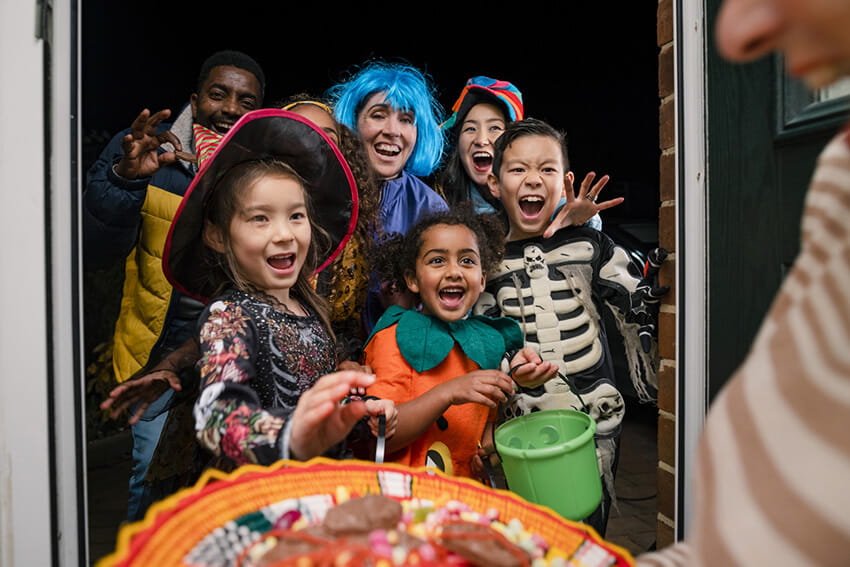Trick-or-treat safety tips

Halloween parades, last-minute costume fixes and trick-or-treating are starting dominating your to-do list. It can only mean one thing: Halloween is coming.
While Halloween is a fun holiday to celebrate, it can also present some serious health risks. For example, walking in costume at night can be risky. Or your kids might focus more on their treats than on where they are going.
Liz Kelly, Nurse Manager of the pediatric unit at Bryn Mawr Hospital, part of Main Line Health, offers tips for making your trick-or-treat outings safe and memorable.
Halloween costume safety tips
A few Halloween costume safety tips can help you and your family stay safe while trick-or-treating. Here are some things to skip when you dress up this year:
- Unless they've been approved by an optometrist or physician, skip the use of novelty contact lenses. Costume accessories may scratch the eye or cause infections, which can lead to pink eye. In serious cases, it could even result in blindness.
- Plastic swords or wands can be fun but, if they're too sharp, can be dangerous if kids slip or fall. So skip the sharp objects, too.
- While masks might seem like an easier option, they can obstruct vision, especially at night. For better safety, opt for costume makeup instead of masks.
- Before applying costume makeup on your child, it's important to perform a patch test. Apply a small amount of the makeup to their arm or another small area of skin to check for any allergic reactions. Even if the product is labeled as safe, individual reactions can vary.
- If your child will wear their costume for a long time, choose a larger size to give them extra room. This will allow them to move comfortably and allow for layers if it's cold outside.
Keep safe when trick-or-treating
Trick-or-treating is a fun part of the holiday for most families, and something many parents cherish with each passing year. With a few tips, you can help keep everyone safe while ensuring they still have fun:
- Trick-or-treating with a group is the safest option
- Walking at night can make it hard for drivers to see you, so carry a glow stick or flashlight for visibility
- Encourage your child to wear comfortable sneakers instead of costume shoes for easier walking
- If your child is out with friends, ensure you know who they’re with and how to contact them in an emergency
- If no one in the group has a cell phone, make sure a supervising parent is available to contact
Halloween candy safety
Before your child starts eating, check their candy and chocolate stash. Look for any pieces that are unwrapped or seem tampered with. Be allergy-aware. If your trick-or-treater has food allergies, you'll have to pay special attention to which treats they're taking. In recent years, more families have joined the Teal Pumpkin Project, This is a nationwide movement where homes with teal pumpkins give treats to children with food allergies. If your child has diabetes or food allergies, Children's Hospital of Philadelphia and the Main Line Health team at Bryn Mawr Hospital are hosting a safe exchange at the Bryn Mawr Hospital Halloween Candy Exchange on November 1, 2024.
This year marks the 20th anniversary of the event! Wear your costume, enjoy face painting and pumpkin carving and exchange your Halloween candy for great prizes and healthy snacks.
To RSVP, please call 484.337.4618 by October 25, 2024 and provide name of the parent/guardian, the child's name and age and a call back number.
Main Line Health and Children's Hospital of Philadelphia (CHOP) have teamed up to provide expert pediatric care to the little humans in our community. The affiliation between CHOP and Main Line Health brings the best of academic medicine — cutting-edge research, standardized clinical pathways that ensure consistency of care and innovative quality improvement projects — close to home for families in the Philadelphia suburbs. Together, we elevate the care your child has access to, leading to improved outcomes and a better quality of life for your family.
Next steps:
Learn more about the Main Line Health and CHOP affiliation
Learn more about pediatric care at Main Line Health
Accident and injury prevention tips to keep kids safe
 Content you want, delivered to your inbox
Content you want, delivered to your inbox
Want to get the latest health and wellness articles delivered right to your inbox?
Subscribe to the Well Ahead Newsletter.
